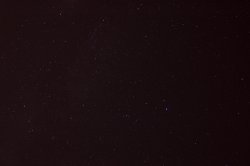Ok, I live in a very light polluted area of the UK, and am very jealous of some of the sky qualities in the pics so far, So anyway, I thought i'd chip in....
I've been experimenting with star trails as part of my astrophotography hobby.
I use various PC apps to assemble what I capture through the SLR, and the SLR attached to my Newtonian Reflector. There are a few good free ones around, but you have to try what your after in each app to find which produces the best results.
So Pic 1, This is a 100 frames stacked image, the advantage being you can use short exposures (8s) and combine them to enhance what the eye can't at first see. (that will make sence on pic 2), but for this pic I havent done that.
As you see, you get the star trail effect (excuse the break in the lines thats where clouds went past and I had to drop the frames, it also explains the photoshop effect you see on the right hand side, also the adjacent line is IIS going over ( that was my original target) and you can see the dotted lines which are aircraft)
So onto pic 2, the same set of 100 pictures, but this time i've opted to stack the stars by aligning them, eliminating (mostly) the rotation.
Notice how the terrible streetlight glow almost disappears and the amount of detail in the sky is dramatically improved.
You also get to experience how much the planet spins rather than the stars rotate.
The next pair of pics are the same 2 processes but i've managed to get an arty farty leaf in with the pole star. It was a clearer night for it!
All this was done with just a Nikon P5100 pocket digital camera, set to take pics 8s each every 10 seconds. I can only get 110 odd pics out of it in 1 battery, and some clever free software.
http://www.astronomie.be/registax/index.html
http://deepskystacker.free.fr/english/index.html
Most of it is windows software im afraid, but I also use Starry Night Pro Plus 6 on the mac for my planning. I can connect my scope to it and it will track objects etc, with my D60 connected to the scope you can get right in there!! Focus then becomes the issue, as you connect the scope directly to the camera body and cant see sod all though the viewfinder so its a bit hit and miss.
So far i've discovered this is a very difficult form of photography....
But M92 didn't come out to badly I suppose...




























